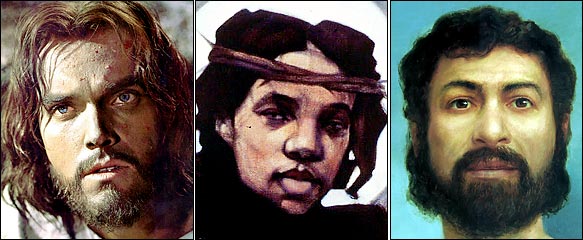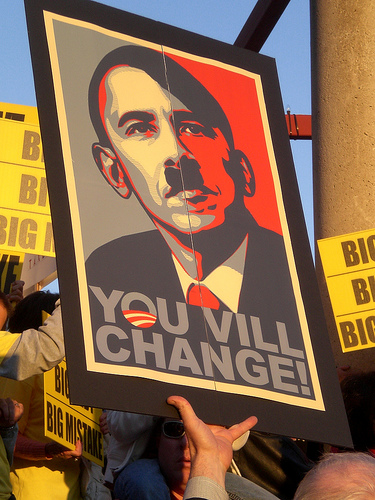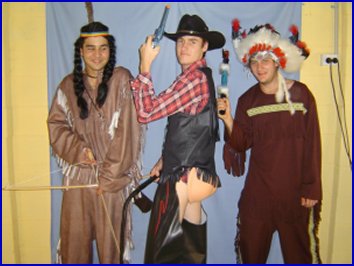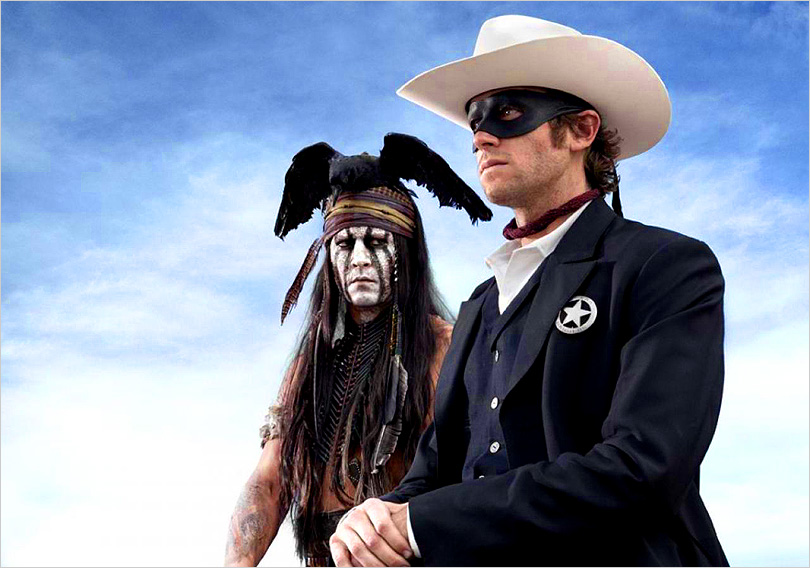Perhaps because of the
40th anniversary of Wounded Knee II, this image was floating around Facebook recently. I didn't pay attention to it until someone asked me about it. Then I reposted it with the following comments:
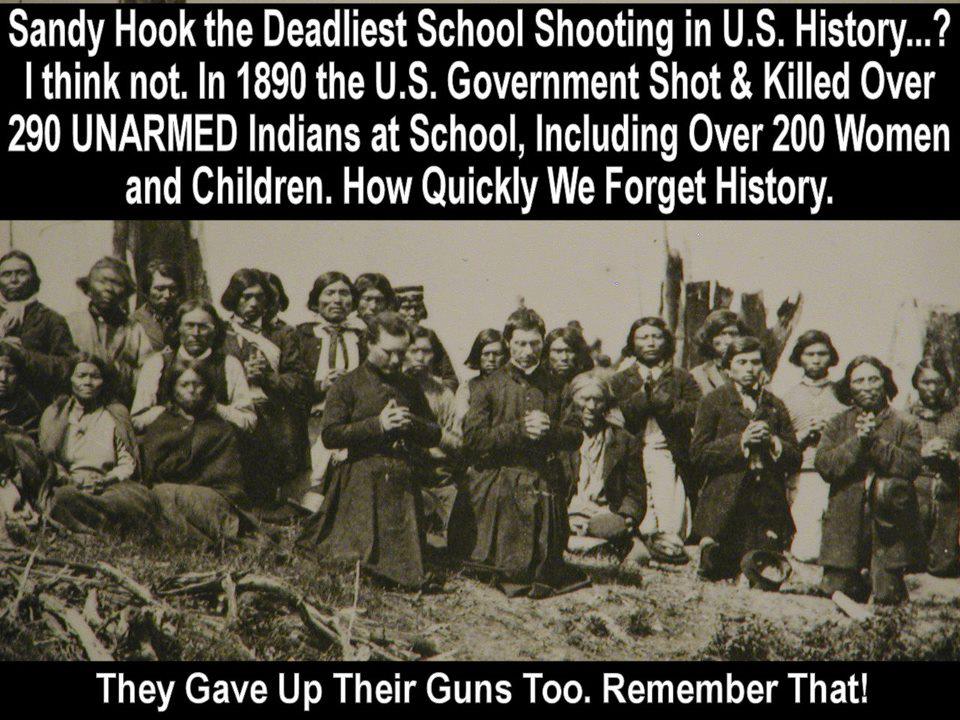
1) Wounded Knee wasn't a school shooting. 2) The massacre happened
while the troops were disarming the Lakota, not after. 3) More guns wouldn't have made a difference since the US had more or less won at that point. 4) Gun nuts are stupid.
Also, no one's proposing to take away people's guns. The right-wing hysteria on this point is...hysterical.
Let the discussion begin
This posting led to the following discussion with a Facebook friend:
I don't get it. Is the claim of this a stretch, a misleading half truth, is that what you're saying? Confusing. Why then the wording "the US gov shot 290 unarmed Indians at School," emphasis on "at School"?? Context here would be good as the words Wounded Knee are absent from the message, and so is anything that would indicate a school. Then the comparison to Sandy Hook which is named, though the location of this pic is not. Very confusing. And yet being 'shared' like crazy, as usual on Fb, so it's appealing to people for some reason. Why do you think that is?
Let me guess: there was a school at the site of WK in 1890?The year and the number dead makes it clear this refers to Wounded Knee. No, there was no school involved in the massacre. The Lakota were camping in a field, not at a school. I doubt any of the people killed had ever attended a white man's school.
The massacre did occur while the Army was taking the Lakotas' guns. Gun fanatics are using this fact to argue against gun control.
I presume they're trying to arouse liberal sympathy by pretending that gun confiscation was behind Wounded Knee and other Indian massacres. As far as I know, a lack of guns wasn't a significant factor in any battle or massacre, so the claim is false.
Why then is this being 'shared' by people, NA people and supporters, with sentiments like "Aho!" and "Never forget, and seemingly without thinking what this meme really says??They aren't as sharp as I am. They're probably not paying attention to the final line. Superficially, the message is, "You think Sandy Hook was bad? Wounded Knee was much worse." But the real message is, "The government kills people after taking their guns, so don't support gun control."
A person doesn't have to be sharp to realize this pic is USING Indian people in a message, yet Indian people are sharing it like crazy. It's insidious.If they're sharing it without thinking about or commenting on it critically, they aren't that sharp. The "290 unarmed Indians at school" line is patently false.
I'm pretty sure the picture isn't from Wounded Knee either. The two guys in front look like white men leading a prayer service. Why would people be lined up to pray just before a massacre when they were surrounded by machine guns?
You saying people can't read? Can't see the distortion of facts here? To me, there'd be nothing wrong with posting the pic alone with "never forget (WK)" and sharing/reposting that. But the text part of this, the message re guns and schools or is CLEARLY out of context. And false.I've told you my theory. People are missing the obvious because Facebook encourages mindless sharing. They may do things mindlessly, but I don't.
If you disagree with this theory, what's your explanation for why people are sharing it? You think they know something about the Wounded Knee massacre that I don't? What, exactly?
Image = propagandaSo why the association to WK? And why this week / today when the 40th anniversary of WK is being observed? INSIDIOUS is what I'm saying. Native people sharing this shit all over Fb breaks my heart, it really does. So much for the "respect" NA people are fighting so hard for, and by not THINKING a simple thought... i.e. "Hey, was there even a school at WK?" or "Where was this pic taken?" In essence, NA people--mostly Democrat leaning people--are sharing R-wing propaganda....against themselves and against credibility. *SMH. Insidious.As I said, you theoretically arouse liberal sympathy for guns by painting the government as an evil killer of innocent unarmed people. Of which Wounded Knee is the most famous example.
Never mind that this same government used force to integrate the schools and safeguard other civil rights. It's silly to think the government still wants to massacre civilians 123 years later.
As for why now, it could be just a coincidence. It's a little farfetched to think anyone's making a connection between Wounded Knee II, which happened in 1973, and this image. Wounded Knee II happened in the same area but it wasn't about the massacre 83 years earlier. Not directly, anyway.
People may be sharing this because everyone's talking about Wounded Knee II today, and it reminds them of Wounded Knee I. But I doubt someone created it to be shared today. I bet it's been floating around for weeks or months, and just gained currency today.
Yea "reminds" of WK (insidious) but is this not obvious distortion to ANYONE who reads it? A school has nothing to do with WK, ought to be the first clue. And this to Indian people who are so proud of KNOWING their history. This is bullshit.The sepia-toned photograph of Indians is meant to remind you of Wounded Knee. But pictures of mangled bodies might not arouse the same sympathy. Perhaps more important, you couldn't pretend Wounded Knee involved a crowd gathered at a school. Showing the poor defenseless "school shooting victims" before the gun-taking government slaughtered them increases the propaganda effect.
As for whether it's obvious, ask people who shared it without commenting on the pro-gun message. Let's see what they say.
P.S. This is a good case for your Word of the Week "insidious." <grin>
Yea har har W.O.D= insidious, I'll laugh later, right now I'm just stunned at the stupidity of people.The photo's origin
Another Facebook friend found the original photo
online:

It's labeled "Kamloops Indian Residential School Priest Parents Indian Children."
Kamloops is in British Columbia. And what exactly is this school? Wikipedia provides the answer:
Kamloops Indian Residential SchoolThe Kamloops Indian Residential School was part of the Canadian residential school system and one of the 130 schools for First Nations children that operated in Canada between 1874 and 1996. The Kamloops School was opened in 1893 (initially as the Kamloops Industrial School) and continued operation until 1977. Hundreds of Secwepemc children attended the school, often forcibly removed from their homes once attendance became mandatory by law.I thought those were tipis in the background of the cropped version. But they may be planks from a cedar house, and pine trees, in the Pacific Northwest. Had I seen the original photo, I might've guessed that.
Not a bad choice for a fraudulent photo. You have Indians from the right era--the 1890s. They're dressed in the clothing of the times. There are no clearcut cultural identifiers such as tipis or totem poles. And the people look like innocents before the slaughter.
So the photo
is from a residential school. Most of the people look like parents, but a few may be children. In any case, it has nothing to do with Wounded Knee or any massacre with 290 dead. As I thought.
My correspondent was so upset by Natives sharing this image that she posted a plea asking them to stop. Perhaps they heeded her, because the image stopped showing up. Or perhaps it ran its course and people moved on to the next Internet meme.
For more on
gun control, see
Gun Nuts Fear "Race War" and
America's Culture Based on Violence.













